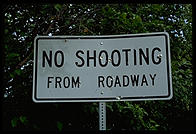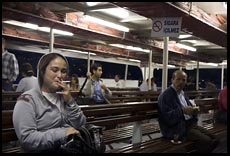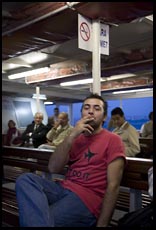
Yes!: 50 Scientifically Proven Ways to Be Persuasive
reviewed by Philip Greenspun; March 2010
Site Home : Book Reviews : One Review

|
Yes!: 50 Scientifically Proven Ways to Be Persuasivereviewed by Philip Greenspun; March 2010
Site Home : Book Reviews : One Review |
This is a summary/review of
Yes!: 50 Scientifically Proven Ways to Be Persuasive
by Goldstein, Martin, and Cialdini, published in 2008. The amazon.com
reviewers say that it is a lame sequel to
Influence: The Psychology of Persuasion
,
which I have not read. I picked up this book in the Nashville, Tennessee airport bookshop
to help with a rewrite of some Web pages advertising our flight school's helicopter training and
Boston helicopter tour operations.
By the time I'd reached page 20, I realized that most of our marketing approach was completely wrong. We had tended to stress the unusualness and distinction of taking a tour or earning a pilot's license. The authors remind the reader that humans are herd animals and would much rather be followers than leaders. Everyone else in the neighborhood driving to the 7-11 in a 6000-lb. SUV? Better go out and get one too. They cite statistical studies of the effect of signs that say "most other people are doing X" and they turn out to be very effective indeed, whether the effect is positive (encouraging hotel guests to reuse towels) or negative and unintended (encouraging National Park visitors to steal petrified wood).



When bundling additional products or services to entice a customer to buy a primary product or service, the gift will be automatically devalued in the consumer's mind, especially if not explicitly labeled with a price. So say "includes a $250 security program at not cost to you" rather than "includes a free security program".
Ouch! Another screw-up for our helicopter tour business. We'd been offering a $179 per person tour of the city of Boston. This is what nearly everyone buys. We also have a $99 per person tour of the historic Revolutionary War towns near the airport. The authors would expect us to be able to increase sales dramatically if we also had a $299 per person tour. People like to buy a mid-range product. And in fact we do have a high-end tour that includes a trip up the shoreline to Marblehead, but its availability is buried.
People are much more likely to buy from you if they've gotten a small gift, even as small as a can of soda. This advice can be used by the consumer. The authors suggest getting a customer service agent's name and information on how to write a letter about what good service he or she is providing before asking the agent to waive a fee or authorize a repair. The agent will feel obligated to do something positive for the customer.
When trying to get someone to fill out a form, put a handwritten Post-It note on top. People subconciously interpret the act of writing the Post-It as something you've done for them and were about twice as likely to make the effort to complete a survey.
Waiters can benefit from the human trait of reciprocity. Instead of having a mint bowl at the exit, a restaurant experimented with having the waiters give each diner a mint at the table. Tips went up 3.3 percent. The number of candies was increased to two per diner. Tips went up 14 percent. Then the waiter changed the presentation of the two candies, giving one first and then returning as if after considering how great the table had been and giving the second. Tips went up 23 percent. A gift ideally should seem significant (not just one candy), unexpected, and personalized.
According to the authors, people are much more likely to do something if they've written down that they're going to do it. Therefore, at some point during or right after the $225 introductory lesson we should be getting students to write down their goals for helicopter training. Perhaps they want to fly four times per year with an instructor in order to experience the satisfaction of poking around the sky. Perhaps they want to get a Private certificate and take friends for rides. Perhaps they want to change careers and become professional helicopter pilots. Any of these goals, if fulfilled, would help our business. They're more likely to do it if they've written it down and we could use the information to tailor their instruction.
Why do American families turn over 5-6 percent of their wealth to a realtor every time they sell a house? Why do authors and actors have agents skimming 10 percent of their income? Why is so much time wasted at conferences with boring introductions of speakers?
The authors explain that, even when there is an obvious commercial bias, people are much more likely to believe a third party speaking about someone's accomplishments than the person him or herself. It can even be the receptionist at a real estate agency talking about how much experience a particular realtor has. We could probably use this at the flight school, by training the four people who work the front desk to, when booking a customer for a tour or a lesson, to say "I'll put you with Paul, he been teaching helicopter students for almost 30 years" or "You'll fly with Philip. He used to fly jets for an airline."
Retailers do better if they are honest about when customers can buy something cheaper at another store. The authors cite Progressive Insurance as an example. Lawyers and expert witnesses do better with juries when they reveal weaknesses in their case and discuss them before the other side brings up the weakness. For a professional student, our flight school's biggest weakness is probably the inconsistent New England weather compared to what the big factory schools in Florida enjoy. We could be bringing that up and explaining that it is good to know how to make weather decisions and to fly in less than ideal conditions. Another weakness that we have is the fact that we use four-seat Robinson R44s rather than the cheaper two-seat R22s. We have just about the lowest rate in the world on the R44, but the two-seater will always be cheaper. The disadvantage to the R22 is that it a terrible trainer aircraft, difficult to fly, unforgiving, and accident-prone. But I'm not sure how we can talk about that without scaring students off (most helicopter training accidents result in the machine being wrecked and students walking away, but the average consumer wouldn't expect that). The book suggests something of the form "The R44 costs more per hour than the R22, but because it is easier to fly you'll be ready for your checkride in fewer hours than if you'd flown the R22."
Incredibly, people choose careers and places to live on the basis of their first name. Men named "Dennis" were disproportionately likely to become dentists. Women named "Louise" move to Louisiana and women named "Florence" move to Florida. How to use this in business? The authors suggest "If you're considering pitching a strategy to someone named Peterson at Pepsi, calling the strategy the Pepsi Proposal or the Peterson Plan would likely be effective."
We might be able to use this at the helicopter school by taking the student's written goals (see above) and developing a document labeled "the Joe Smith Plan" for their training, with a customized schedule.
Citing the famous study in which people were more likely to let someone break into a line for a Xerox machine if told "May I use the Xerox machine, because I have to make copies" (a tautological reason), the authors suggest using the powerful word "because" as much as possible. The best thing to do is get customers to use it themselves, e.g., asking them to fill out surveys about why they use your service. We did this recently by asking customers to go to Facebook and Yelp and write reviews of East Coast Aero Club. The Yelp project did not work out at all well. About 20 customers registered with Yelp and entered positive reviews, but then Yelp deleted nearly all of them. Folks have explained to us that Yelp only publishes positive reviews on the pages of companies who pay them to be listed (flight school owners are famously unwilling to part with money!).
Rhyming slogans and statements are powerful: "Researchers found that even though all of the participants in the study strongly held the belief that rhyming was in no way an indicator of accuracy, they nonethless, they nonetheless perceived the statements that rhymed as more accurate than those that didn't." I'm at a loss as to how to use this. What rhymes with "East Coast Aero Club"? Or with "Helicopter Tour"? Or with "Helicopter training"? "You'll love our helicopter training except when it's raining"?
Consumers buy more if they learn a little about a contrasting product first. We could use this at East Coast Aero Club, which has 35 airplanes and 2 helicopters, by talking about airplane flying before trying to sell helicopter flying.
Researchers found that consumers found colors and flavors more appealing when they were puzzling, e.g., "Kermit green" rather than "green" or "millenium orange" rather than "orange". In trying to figure out what the name meant, consumers were apparently prompted to think of positive aspects of the product. If they solved a mini-puzzle by figuring out the meaning of a name they ended up with positive associations. We could potentially use this in our business, e.g., renaming the Boston Helicopter Tour the "Revere Ride Reverse" (we go into Boston by reversing the route that Paul Revere took in 1775). I'm not sure how to rename a one-hour flight lesson.
Caffeine makes people more receptive to legitimately persuasive arguments. The effect of caffeine is greatest about 40 minutes after a drink is consumed, so timing is everything. Perhaps this is why rug merchants in the Istanbul bazaar always offer coffee to every customer.
Telephone and face-to-face interactions are much more likely to get people to agree to a deal than email exchanges. If you must use email, e.g., as we do with European customers who book tours, it helps quite a bit to include some personal information, such as a photograph, with the emails.
I'm not a fan of the business bestseller. Most of the ones that I've
found are legitimate 20-page essays that have been padded with 200
pages of dross in order to form a standard length book. Yes!, however, has a high density of useful
ideas. It completely changed our ideas of how to market helicopter
training and tours.
Mr. Greenspun thanks for the book review,
Yes! is indeed a great book on persuasion, I've gotten through most of it on a skim basis but will likely go through again with a more thorough study. Your key points summarized here are nice and I will keep them bookmarked.
I really like how you include pictures to make email seem more genuine online. I think you might consider some of the ideas in Dale Carnegie's book, "How to Win Friends and Influence People." I've been trying to apply these as an online, internet model. In fact I think a newer book called "How to Win Friends and Influence People Online," would be a best seller.
I've changed my model to always start messages in a friendly way. I try to listen more and ask questions about the other persons point of view. With email this is hard, but I always answer every questions I am asked. With each message I try to think about the person I am talking to, not the machine. I also give digital encouragement and praise.
Really, I've found that taking this book and imagining everything in an online environment is a nice exercise for improving online business. Perhaps it might help you with your tour business.
Best wishes,
Kristy H.
-- Kristy Harris, April 16, 2011
Phil, I had a similar response to this book with regards to my own company's marketing strategies. Did you implement any of these methods, and if so did they make a difference?
-- Michael Schirmer, September 2, 2011